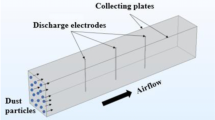Abstract
The majority of existing approaches to computation of electrostatic precipitator (ESP) efficiency do not take into account particle reentrainment from collecting electrodes. The first attempts to take into consideration particle reentrainment were made only recently. However, the existing reentrainment models for ESP are not sufficiently substantiated. A general model, which takes into account precipitation of particles, entering the ESP inlet (direct precipitation), as well as precipitation of reentrained particles (secondary precipitation), is presented in the paper. The model describes physical processes in an ESP using three integral parameters. These parameters are direct precipitation coefficient, secondary precipitation coefficient, and reentrainment coefficient, which is the ratio of reentrained particle flux to precipitation flux. An improved technique for computation of direct precipitation that takes into account particle charge distribution function is proposed. The influence of gas flow turbulence on charge distribution function parameters, as well as on other parameters of precipitation phenomena, is taken into account. The method has low computational costs. The secondary precipitation coefficient is also computed using this method. The most difficult task is calculation of the reentrainment coefficient. We suggest using data of periodical ESP testing to determine the reentrainment coefficient. The analysis of experimental data indicates that a fly ash layer on collecting electrodes is of paramount importance. It has been shown that the flux per unit length of particles falling into hoppers is proportional to weight (thickness) per unit length of the fly ash layer. Distributions of precipitation flux, flux into hoppers, reentrained particle flux along the ESP duct, and particle penetration through the ESP are computed using experimental data. A novel model that is based on a flux balance equation for each length element of an ESP duct is presented. The model has the form of a connection between physical phenomena that take place on two successive length elements of the collecting electrode. The model qualitatively agrees with experimental data. However, correction of the secondary precipitation coefficient and the reentrainment coefficient is required for quantitative agreement. In this regard, a model of layer growth and determination of functional relations between layer weight, hopper flux, and particle penetration play a key role.
Similar content being viewed by others
References
Levitov, V.I., Reshidov, I.K., Tkachenko, V.M., et al., Dymovye elektrofil’try (Smoke Electric Filters), Levitov, V.I., Ed., Moscow: Energiya, 1980.
Schmid, H.-J. and Vogel, L., On the modelling of the particle dynamics in electro-hydrodynamic flow-fields: I. Comparison of Eulerian and Lagrangian modelling approach, Powder Technol., 2003, vols. 135–136, pp. 118–135.
Bacchiega, G., Gallimberti, I., Sani, E., et al., Experimental study of the mass balance in a pilot industrial electrostatic precipitator, J. Electrostat., 2006, vol. 65, no. 5, pp. 297–309.
Caraman, N., Bacchiega, G., Gallimberti, I., et al., Development of an industrial model of rapping-effect on the collecting efficiency, Proc. 10th ICESP, Cairns, 2006.
Vereshchagin, I.P., Smagin, K.A., and Timofeev, E.M., The way to improve the calculating method for processes taking place in electric filters for cleaning thermal power-station smoke gases from ash, Elektrichestvo, 2015, no. 6, pp. 12–19.
Parker, K.R., Applied Electrostatic Precipitation, Blackie Academic & Professional, 1997.
Vereshchagin, I.P., Levitov, V.I., Mirzabekyan, G.Z., et al., Osnovy elektrogazodinamiki dispersnykh sistem (Foundations of Dispersed Systems Electric Gas Dynamics), Moscow: Energiya, 1974.
Fuks, N.A., Mekhanika aerozolei (Aerosols Mechanics), Moscow: USSR Acad. Sci., 1955.
Author information
Authors and Affiliations
Corresponding author
Additional information
Original Russian Text © I.P. Vereshchagin, S.I. Khrenov, K.A. Smagin, L.V. Chekalov, E.M. Timofeev, 2016, published in Elektrotekhnika, 2016, No. 8, pp. 43–52.
About this article
Cite this article
Vereshchagin, I.P., Khrenov, S.I., Smagin, K.A. et al. A new approach to calculation of flue gas scrubbing efficiency in electrostatic precipitators. Russ. Electr. Engin. 87, 467–475 (2016). https://doi.org/10.3103/S1068371216080113
Received:
Published:
Issue Date:
DOI: https://doi.org/10.3103/S1068371216080113




